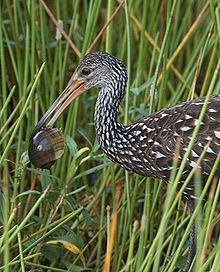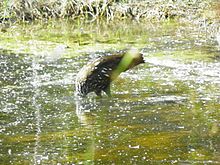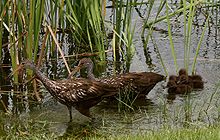- Limpkin
-
Limpkin 
Conservation status Scientific classification 
Kingdom: Animalia Phylum: Chordata Class: Aves Order: Gruiformes Family: Aramidae
Bonaparte, 1849Genus: Aramus
Vieillot, 1816Species: A. guarauna Binomial name Aramus guarauna
(Linnaeus, 1766)
Global distribution The Limpkin (also called "carrao", "courlan", "crying bird"), Aramus guarauna, is a bird that looks like a large rail but is skeletally closer to cranes. It is the only extant species in the genus Aramus and the family Aramidae. It is found mostly in wetlands in warm parts of the Americas, from Florida to northern Argentina. It feeds on molluscs, with the diet dominated by apple snails of the genus Pomacea. Its name derives from its seeming limp when it walks.[2]
Contents
Taxonomy and systematics
The Limpkin is placed in its own monotypic family, Aramidae, which is in turn placed within the crane and rail order Gruiformes. It had been suggested that the Limpkin was close to the ibis and spoonbill family Threskiornithidae, based upon shared bird lice. The Sibley-Ahlquist taxonomy of birds, based upon DNA-DNA hybridization, suggested that the Limpkin's closest relatives were the Heliornithidae finfoots, and Sibley and Monroe even placed the species in that family in 1990.[3] More recent studies have found little support for this relationship.[4] More recent DNA studies have confirmed a close relationship with particularly the cranes,[5] with the Limpkin remaining as a family close to the cranes and the two being sister taxa to the trumpeters.[6]
Although the Limpkin is the only extant species in the family today, there are several fossils of extinct Aramidae known from across the Americas. The earliest known species in the genus Aramus, Aramus paludigrus is dated to the middle Miocene,[7] while the oldest supposed members of the family, Aminornis and Loncornis, have been found in early Oligocene deposits in Argentina, although it is not certain that these are indeed related.[4] Another Oligocene fossil from Europe, Parvigrus pohli (family Parvigruidae), has been described as a mosaic of the features shared by the limpkins and the cranes. It shares many morphological features with the cranes and limpkins, but also was much smaller than either group, and was more rail-like in its proportions. In the paper describing the fossil Gerald Mayr suggested that it was similar to the stem species of the Grues (the cranes and limpkins), and that the limpkins evolved massively long bills as a result of the specialisation to feeding on snails. In contrast, the cranes evolved into long-legged forms to walk and probe on open grasslands.[8]
Description
The Limpkin is a somewhat large bird, 66 cm (26 in) long, with a wingspan of about 102 cm (40 in) and a weight of about 1.1 kg (2.4 lb). The males are slightly larger than the females in size, but there is no difference in plumage.[4] Its plumage is drab—dark brown with an olive luster above. The feathers of the head, neck, wing coverts, and much of the back and underparts (except the rear) are marked with white, making the body look streaked and the head and neck light gray. It has long, dark-gray legs and a long neck. Its bill is long, heavy, and downcurved, yellowish bill with a darker tip.[9][10] The bill is slightly open near but not at the end to give it a tweezers-like action in removing snails from their shells, and in many individuals the tip curves slightly to the right, like the apple snails' shells.[11] The white markings are slightly less conspicuous in first-year birds.[10] Its wings are broad and rounded and its tail is short.[12] It is often confused with the immature White Ibis.
This bird is easier to hear than see. Its common vocalization is a loud wild wail or scream[9][12] with some rattling quality, represented as "kwEEEeeer or klAAAar."[10] This call is most often given at night[12] and at dawn and dusk.[9] It has been used for jungle sound effects in Tarzan films[13] and for the hippogriff in the film Harry Potter and the Prisoner of Azkaban.[14] Other calls include "wooden clicking",[10] clucks,[12] and in alarm, a "piercing bihk, bihk...".[9]
Range and habitat
The Limpkin occurs from peninsular Florida (and formerly the Okefenokee Swamp in southern Georgia)[15] and southern Mexico through the Caribbean and Central America to northern Argentina. In South America it occurs widely east of the Andes; west of them its range extends only to the Equator.[9][12]
It inhabits freshwater marshes and swamps, often with tall reeds, as well as mangroves.[9][12] In the Caribbean, it also inhabits dry brushland.[12] In Mexico and northern Central America, it occurs at altitudes up to 1,500 m (4,900 ft).[9] In Florida the distribution of apple snails is the best predictor of where Limpkins can be found.[4]
The Limpkin undertakes some localised migrations, although the extent of these are not fully understood. In some parts in the northern part of the range females (and a few males) will leave the breeding areas at the end of summer, returning at the end of winter. Birds may also migrate between Florida and Cuba. In Brazil birds breeding in some seasonal marshes will leave during the dry season and return again with the rains.[4]
Behavior
Limpkins are largely nocturnal and crepuscular, except that in Florida refuges, where they do not fear people, they are active during the day.[12] Even so, they are usually found near cover.[9]
Because of their long toes, they can stand on floating water plants. They also swim well, both as adults or as newly hatched chicks, but they seldom do so.[4] They fly strongly, the neck projecting forward and the legs backward,[12] the wings beating shallowly and stiffly, with a jerky upstroke, above the horizontal most of the time.[9]
Feeding
Limpkins forage primarily in shallow water and on floating vegetation such as water hyacinth and water lettuce.[16] When wading they seldom go deeper than having half the body underwater, and never are submerged up to the back.[4] They walk slowly with a gait described as "slightly undulating" and "giving the impression of lameness or limping",[12] "high-stepping",[9] or "strolling",[10] looking for food if the water is clear or probing with the bill.[11][12] They do not associate with other birds in mixed-species feeding flocks, as do some other wading birds, but may forage in small groups with others of their species.[17]
The diet of the Limpkin is dominated by apple snails (Ampullariidae) of the genus Pomacea. The availability of this one mollusk has a significant effect on the local distribution of the Limpkin.[18] Freshwater mussels, including Anodonta cowperiana, Villosa vibex, Elliptio strigosus, E. jayensis, and Uniomerus obesus, as well as other kinds of snails, are a secondary food sources.[4] Less important prey items are insects, frogs, lizards, crustaceans and worms.[12] These prey items may be important in periods of drought or flooding when birds may be pushed into less than optimal foraging areas.[4] In one site in Florida moon snails and mussels were the most important prey items.[4] Two studies, both in Florida, have looked at the percentage composition of the diet of Limpkins. One, looking at stomach contents, found 70% Pomacea apple snails, 3% Campeloma and 27% unidentified mollusc, probably Pomacea.[4][18]
When a Limpkin finds an apple snail, it carries it to land or very shallow water and places it in mud, the opening facing up. It deftly removes the operculum or "lid" and extracts the snail,[12] seldom breaking the shell. The extraction takes 10 to 20 seconds.[11] The orange-yellow yolk gland of female snails is usually shaken loose and not eaten.[4] It often leaves piles of empty shells at favored spots.[12]
Reproduction and breeding
Males have exclusive territories, which can vary in size from just 0.15 to 4 hectares. In large uniform swamps nesting territories can often be clumped together, in the form of large colonies. These are vigorously defended, with males flying to the territory edges to challenge intruders and passing Limpkins being chased out of the territory. Territorial displays between males at boundaries include ritualized charging and wing-flapping. Females may also participate in territorial defence but usually only against other females or juveniles. Territories may be maintained year-round or abandoned temporarily during the non-breeding season, usually due to lack of food.[4]
Limpkins may be either monogamous, with females joining a male's territory, or serially polyandrous, with two or more females joining a male. With the monogamous pairs, banding studies have shown that a small number of pairs will reform the following year (4 out of 18 pairs).[4]
Nests maybe be built in a wide varaiety of places, either on the ground, in dense floating vegetation,[19] in bushes, or at any height in trees. They are bulky structures of rushes, sticks or other materials. Nest building is undertaken by the male initially, who will construct the nest in his territory prior to pair-bond formation. Unpaired females will visit a number of territories before settling on a male to breed with. Males may initially challenge and fight off prospective mates, and may not accept first-year females as mates. Pair-bond formation may take a few weeks. Courtship feeding is part of the bonding process, where males catch and process a snail and then feed it to the female.[4]
The clutch consists of 3 to 8 eggs, with 5 to 7 being typical and averaging 5.5,[4] which measure 6.0 × 4.4 cm (2.4 × 1.7 in). The egg color is highly variable. Their background color ranges from gray-white through buff to deep olive, and they are marked with light-brown and sometimes purplish-gray blotches and speckles. The eggs are laid daily until the clutch is complete, and incubation is usually delayed until the clutch is completed. Both parents incubate the eggs during the day, but only the female incubates at night. The shift length is variable, but the male incubates for longer during the day. The male remains territorial during incubation, and will leave the clutch to chase off intruders; if this happens the female will return quickly to the eggs. The incubation period is about 27 days, and all the eggs hatch within 24 hours of each other.[4]
The young hatch covered with down, capable of walking, running, and swimming. They follow their parents to a platform of aquatic vegetation where they will be brooded. They are fed by both parents; they reach adult size at 7 weeks and leave their parents at about 16 weeks.[11][12]
Ecology
Limpkins are reported to be attacked and eaten by American Alligators. There are also reports of adults with serious foot and leg injuries, suggesting that they may have been attacked by turtles while standing on floating vegetation. Their nests are apparently predated by snakes, racoons, crows and muskrats.[4] Foraging adults may in times of drought be victims of kleptoparasitism by Snail Kites,[20] and the attempted theft of apple snails caught by Limpkins has also been observed in Boat-tailed Grackles.[17]
See also
References
- ^ BirdLife International (2004). Aramus guarauna. 2006. IUCN Red List of Threatened Species. IUCN 2006. www.iucnredlist.org. Retrieved on 11 May 2006.
- ^ *"National Geographic" Field Guide to the Birds of North America ISBN 0-7922-6877-6
- ^ Sibley, C.G.; Monroe Jr., B.L. (1990). Distribution and Taxonomy of Birds of the World. New Haven, CT: Yale University Press. ISBN 978-0300049695.
- ^ a b c d e f g h i j k l m n o p q r Dana, Bryan (2002). Poole, A.. ed. Limpkin (Aramus guarauna). The Birds of North America Online. Ithica: Cornell Lab of Ornithology. doi:10.2173/bna.627. http://bna.birds.cornell.edu/bna/species/627. Retrieved 24 February 2010.
- ^ Livezey, B.C. (1998). "A phylogenetic analysis of the Gruiformes (Aves) based on morphological characters, with an emphasis on the rails (Rallidae)". Philos Trans R Soc Lond B 353 (1378): 2077–2151. doi:10.1098/rstb.1998.0353.
- ^ Fain, Matthew G.; Krajewski, Carey & Peter Houde (2007). "Phylogeny of “core Gruiformes” (Aves: Grues) and resolution of the Limpkin–Sungrebe problem". Molecular Phylogenetics and Evolution 43 (2): 515–529. doi:10.1016/j.ympev.2007.02.015. PMID 17419074.
- ^ Rasmussen, Tab, 1997. "Birds". In: R.F. Kay; R.H. Madden; R.L. Cifelli & J.J. Flynn (eds.) Vertebrate paleontology in the neotropics - the Miocene fauna of La Venta, Colombia. Smithsonian Institution Press.
- ^ Mayr, Gerald (2005). "A chicken-sized crane precursor from the early Oligocene of France". Naturwissenschaften 92 (8): 389–393. doi:10.1007/s00114-005-0007-8. PMID 16052357.
- ^ a b c d e f g h i j Howell, Steve N. G.; Webb, Sophie (1995). A Guide to the Birds of Mexico and Northern Central America. Oxford University Press. p. 248. ISBN 0-19-854012-4
- ^ a b c d e Sibley, David Allen (2000). The Sibley Guide to Birds. Alfred Knopf. p. 156. ISBN 0-679-45122-6
- ^ a b c d "All About Birds: Limpkin". Cornell Lab of Ornithology. http://www.birds.cornell.edu/AllAboutBirds/BirdGuide/Limpkin_dtl.html. Retrieved 2009-02-01.. Includes a sound file.
- ^ a b c d e f g h i j k l m n o Holyoak, David; Colston, P. R. (2003). "Limpkin". In Christopher Perrins. The Firefly Encyclopedia of Birds. Firefly Books. pp. 212–213. ISBN 1-55297-777-3
- ^ Phillips, James. "The Peace River: Natural History". Southwest Florida Water Management District. http://www.swfwmd.state.fl.us/education/interactive/peaceriver/natural.php. Retrieved 2009-01-30.
- ^ Ramanujan, Krishna (2005-12-01). "Blockbuster Sounds". Chronicle Online. Cornell News Service. http://www.news.cornell.edu/stories/Dec05/HarryPotter.kr.html. Retrieved 2009-01-30.
- ^ Peterson, Roger Tory (1947). A Field Guide to the Birds: Eastern Land and Water Birds (second revised and enlarged ed.). Houghton Mifflin Company. pp. 57–58
- ^ Stevenson, Henry (1994). The Birdlife of Florida. Gainesville: University Press of Florida. ISBN 0813012880
- ^ a b Bennetts, Robert; Victoria J. Dreitz (1997). "Possible Use of Wading Birds as Beaters by Snail Kites, Boat-Tailed Grackles, and Limpkins". Willson Bulletin 109 (1): 169–173. http://elibrary.unm.edu/sora/Wilson/v109n01/p0169-p0173.pdf. Retrieved 2010-02-24.
- ^ a b Cottam, Clarence (1936). "Food of the Limpkin". Wilson Bulletin 48 (1): 11–13. http://elibrary.unm.edu/sora/Wilson/v048n01/p0011-p0013.pdf.
- ^ Nicholson, Donald J. (1928). "Habits of the Limpkin in Florida". Willson Bulletin 45 (3): 305–309. http://elibrary.unm.edu/sora/Auk/v045n03/p0305-p0309.pdf
- ^ Miller, Bruce W.; Ronald L. Tilson (1985). "Snail Kite kleptoparasitism of Limpkins". The Auk 102 (1): 170–171. http://elibrary.unm.edu/sora/Auk/v102n01/p0170-p0171.pdf.
External links
- Limpkin videos, photos & sounds on the Internet Bird Collection
- Limpkin Bird Sound
Categories:- IUCN Red List least concern species
- Gruiformes
- Genera of birds
- Monotypic bird genera
- Wading birds
- Birds of Central America
- Birds of the Caribbean
- Birds of South America
- Birds of the Guianas
- Animals described in 1766
- Monotypic bird families
Wikimedia Foundation. 2010.






